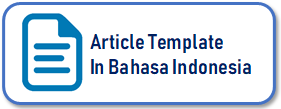Hubungan Umur dan Paritas dengan Breastfeeding Self Efficacy Ibu Nifas
DOI:
https://doi.org/10.22487/ghidza.v8i1.1217Keywords:
Breastfeeding Self Efficacy, Umur, Paritas, Ibu NifasAbstract
Cakupan pemberian ASI Ekslusif sampai saat ini masih rendah yaitu sebesar 37,3%. Salah satu faktor yang mendukung keberhasilan pemberian ASI Esklusif adalah faktor internal ibu khususnya Breastfeeding Self Efficacy (BSE). Tujuan penelitian ini untuk menganalisis hubungan umur dan paritas dengan BSE pada ibu nifas. Penelitian ini merupakan penelitian cross sectional. Responden penelitian adalah 30 orang ibu nifas, dengan teknik pengambilan consecutive sampling sesuai dengan kriteria inklusi dan eksklusi. Pengukuran BSE menggunakan kuesioner breastfeeding self-efficacy scale short form (BSES-SF) dengan validitas dan reabilitas instrumen koefisien cronbach’s alpha sebesar 0,87213. Analisis data menggunakan uji fisher’s exact untuk menganalisis hubungan antar variabel. Hasil penelitian menunjukkan sebagian besar responden penelitian berada pada kategori usia reproduksi sehat (86,67%), pendidikan terakhir adalah pendidikan menengah (46,7%), status bekerja (76,7%), primipara (66,67%) dan BSE pada kategori rendah (56,67%). Uji bivariat menunjukkan tidak ada hubungan umur dengan BSE (p=0,6) dan tidak ada hubungan paritas dengan BSE (p=0,7). Simpulan dari penelitian ini adalah tidak terdapat hubungan umur dan paritas dengan BSE. Disarankan agar edukasi pada ibu nifas dilakukan secara berkelanjutan untuk meningkatkan efikasi dan cakupan ASI eksklusif.
Downloads
References
2. Badan Pusat Statistik Indonesia. (2023). Profil Statistik Kesehatan 2023. Badan Pusat Statistik Indonesia. https://www.bps.go.id/id/publication/2023/12/20/feffe5519c812d560bb131ca/profil-statistik-kesehatan-2023.html
3. Dinas Kesehatan Provinsi Bali. (2021). Profil Kesehatan Provinsi Bali. Dinas Kesehatan Provinsi Bali.
4. Fitriana, N., Raharjo, B. B., & Wijayanti, Y. (2021). Factors Analysis of Exclusive Breastfeeding Through Breastfeeding Self-Efficacy in Pemalang. Public Health Perspective Journal, 6(3), Article 3.
5. Gerbino, M. (2020). Self‐efficacy. In B. J. Carducci, C. S. Nave, & C. S. Nave (Eds.), The Wiley Encyclopedia of Personality and Individual Differences (1st ed., pp. 387–391). Wiley. https://doi.org/10.1002/9781118970843.ch243
6. Jannung, O., Nailufar, F., Satriani, S., & Wahyutri, E. (2024). The Effect of Breastfeeding Education Using Leaflet Media on the Knowledge and Attitudes of Pregnant Women. Journal of Health and Nutrition Research, 3(1), Article 1. https://doi.org/10.56303/jhnresearch.v3i1.188
7. Kementerian Kesehatan Republik Indonesia. (2015). Buku Ajar Kesehatan Ibu Dan Anak. Pusat Pendidikan dan Pelatihan Tenaga Kesehatan. https://ebook.poltekkestasikmalaya.ac.id/2021/08/03/buku-ajar-kesehatan-ibu-dan-anak/
8. Kementerian Kesehatan Republik Indonesia. (2018). Laporan Riset Kesehatan Dasar Tahun 2018 (Indonesian National Basic Health Survey in 2018). Kementerian Kesehatan Republik Indonesia.
9. Khusniyati, E., & Purwati, H. (2024). Analysis of Breastfeeding Self-Efficacy (BSE) in Breastfeeding Mothers. Journal of Scientific Research, Education, and Technology (JSRET), 3(1), Article 1. https://doi.org/10.58526/jsret.v3i1.327
10. Lücke, S., Koch, S., Böl, G.-F., & Flothkötter, M. (2022). [Social acceptance of public breastfeeding over time: Experiences and attitudes of the population and of breastfeeding mothers in 2016 and 2020]. Bundesgesundheitsblatt, Gesundheitsforschung, Gesundheitsschutz, 65(11), 1188–1196. https://doi.org/10.1007/s00103-022-03596-x
11. Mizrak, B., Ozerdogan, N., & Colak, E. (2017). The Effect of Antenatal Education on Breastfeeding Self-Efficacy: Primiparous Women in Turkey. International Journal of Caring Sciences, 10(1), 503–510.
12. Ngo, L. T. H., Chou, H.-F., Gau, M.-L., & Liu, C.-Y. (2019). Breastfeeding self-efficacy and related factors in postpartum Vietnamese women. Midwifery, 70, 84–91. https://doi.org/10.1016/j.midw.2018.12.014
13. Oberfichtner, K., Oppelt, P., Fritz, D., Hrauda, K., Fritz, C., Schildberger, B., Lastinger, J., Stelzl, P., & Enengl, S. (2023). Breastfeeding in primiparous women – expectations and reality: A prospective questionnaire survey. BMC Pregnancy and Childbirth, 23, 654. https://doi.org/10.1186/s12884-023-05971-1
14. Pasaribu, C. J., Togatorop, L., & Bangun, A. (2024). Hubungan Faktor Determinan Dengan Pemberian ASI Ekslusif Pada Bayi 0-6 Bulan Di Kelurahan Kemenangan Tani. BEST Journal (Biology Education, Sains and Technology), 7(1), Article 1. https://doi.org/10.30743/best.v7i1.8877
15. Peran, P., Satriani, S., Joto, N. A., & Wiryanto, W. (2024). The Effect of Exclusive Breastfeeding Education on Changes in Knowledge and Attitudes of Toddler Mothers. Journal of Health and Nutrition Research, 3(1), Article 1. https://doi.org/10.56303/jhnresearch.v3i1.190
16. Peraturan Pemerintah Republik Indonesia Nomor 33 Tahun 2012 Tentang Pemberian Air Susu Ibu Eksklusif (2012). http://peraturan.bpk.go.id/Details/5245/pp-no-33-tahun-2012
17. Sabilla, M., & Ariasih, R. A. (2022). Analisis Breastfeeding Self-efficacy pada Ibu Menyusui. Jurnal Semesta Sehat (J-Mestahat), 2(1), Article 1. https://doi.org/10.58185/j-mestahat.v2i1.84
18. Sayangi, W., Nababan, D., Siregar, L. M., Manurung, K., & Bangun, H. A. (2024). Determinan Pemberian Asi Eksklusif Di Wilayah Kerja Puskesmas Lahomi Kecamatan Lahomi. PREPOTIF : JURNAL KESEHATAN MASYARAKAT, 8(1), Article 1. https://doi.org/10.31004/prepotif.v8i1.26610
19. Tsaras, K., Sorokina, T., Papathanasiou, I. V., Fradelos, E. C., Papagiannis, D., & Koulierakis, G. (2021). Breastfeeding Self-efficacy and Related Socio-demographic, Perinatal and Psychological Factors: A Cross-sectional Study Among Postpartum Greek Women. Materia Socio-Medica, 33(3), 206–212. https://doi.org/10.5455/msm.2021.33.206-212
20. Wulandari, P., Susilawati, S., & Sutrisno, S. (2021). Studi Literatur: Faktor-Faktor yang Mempengaruhi Breastfeeding Self Efficacy. Malang Journal of Midwifery (MAJORY), 3(2), Article 2. https://doi.org/10.31290/majory.v3i2.2864
Downloads
Published
Issue
Section
License
Ghidza: Jurnal Gizi dan Kesehatan is licensed under a Creative Commons Attribution-Share Alike 4.0 International License
All articles published Open Access are free for everyone to read and download. Under the CC-BY-SA license, authors retain ownership of the copyright for their article, but authors grant others permission to use the content of publications in Ghidza: Jurnal Gizi dan Kesehatan in whole or in part provided that the original work is properly cited.
Users (redistributors) of Ghidza: Jurnal Gizi dan Kesehatan are required to cite the original source, including the author's names, Ghidza: Jurnal Gizi dan Kesehatan as the initial source of publication, year of publication, and volume number.














.png)

.png)
1.png)



